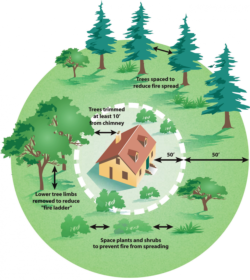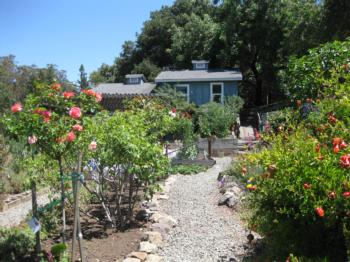Firewise Landscaping
While no one wants to lose a home to wildfire, many residents wonder exactly what they have to do to create a fire safe landscape. Creating defensible space does not mean razing every living thing within 100 feet of your home and it doesn’t have to be expensive: Look for what burns. Regular yard maintenance will take care of short-term requirements and planning can mean less work in the future.
Start now
Prune out dead wood in trees and shrubs. Also, prune carefully to thin out new growth; don’t use hedge clippers or shears—that can encourage more growth. Two goals here: remove fuel and eliminate fire ladders. Depending on the circumstances, thin out new foliage using bypass loppers, pruning shears or a limb saw. Create vertical gaps of at least 6 feet between shrubs and lower tree branches to help keep fire out of the treetops. The better practice is to maintain a vertical distance between branches and shrubs of three times the height of the shrub. Prune back tree limbs that overhang the house, chimney or utility lines. It’s not necessary to cut down trees, just create 10 or more feet of vertical space between tree limbs and a roof or power line.
Mow grasses, pull or weed whack weeds, especially before seeds form. Rake up cuttings and compost or otherwise dispose of them. Dead grasses and weeds are tinder waiting for the spark. Mow and trim in the morning before the humidity drops and heat builds later in the day.
Keep the lawn and garden plants within 10 to 30 feet of your house well watered. Even with watering restrictions, careful water management will keep things looking green. Avoid watering during the heat of the day; early mornings are the best time to water. As tempting as it is to water daily for a short time, the best water management practice is to water longer and less often.
The University of California’s Garden Web, has free information and downloadable publications about defensible space and fire wise or fire safe landscaping. For more information, read:
Future planning
Creating defensible space doesn’t have to mean boring landscapes. Fire-resistant plants will add color and texture to your garden, in addition to storing water in leaves and stems and controlling erosion. Avoid choices that include waxy or resinous plants or plants that have a lot of fine, twiggy material. Instead, look for lower growing and water-retaining plants. Whether edible plants, natives or introduced ornamentals, choices are endless. For more information about fire-resistant options, download this free publication:
“Lassen County and Northeastern California Landscaping Plant Guide”
Calflora catalogs native and non-natives species by scientific, common or family name with plenty of pictures. The website cross-references annuals, grasses, perennials, trees and shrubs by county, habitat and elevation.
Spacing and location of plants are the secret to successful and attractive fire wise landscaping.Consider decomposed granite, gravel or stone walkways and outdoor seating areas to separate plant groupings. Hardscape features—non-vegetative landscape elements—will act as mini firebreaks. Create pockets or islands of plants.
Space it out and break it up to avoid continuous vegetation that might feed a wildfire. Your landscaping will be safer and more interesting.
Learn More
Firewise Landscaping Online Course
Wildland Fire Safety Starts at Home
Defensible Space Guidelines

- Create and maintain a defensible space of at least 100 feet or greater from each building or structure.
- Keep plants low and make sure irrigation is available when needed for plants within 30 feet of your home.
- Plant firewise plants and other vegetation in well-spaced groupings.
- Eliminate ladder fuels within the defensible space zone by disrupting the vertical and/or horizontal continuity of plants. Keep trees well-pruned and separate vegetative groupings by hardscapes.
Adapted from CAL FIRE guidelines

Napa County UCCE Master Gardener demonstration garden at Connolly Ranch

